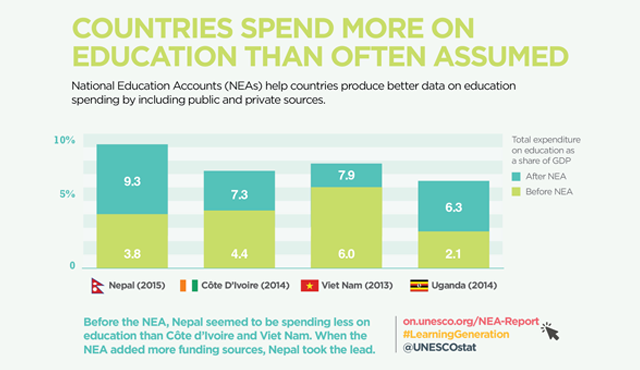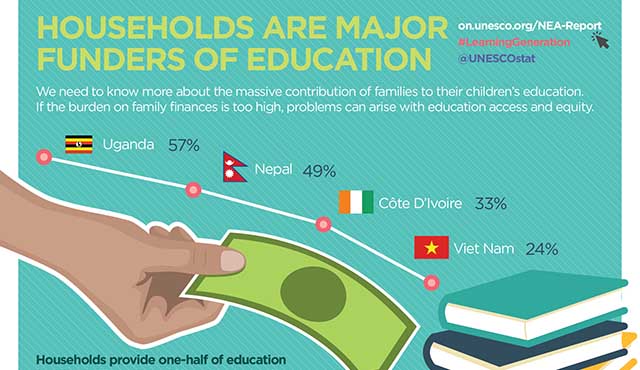By Alice Albright, Chief Executive Officer of the Global Partnership for Education, Suzanne Grant Lewis, Director of the International Institute for Education Planning, and Silvia Montoya, Director of the UNESCO Institute for Statistics.
Last week, the Education Commission released a major report, calling for a new compact between developing countries and the international community to transform education performance, innovation, inclusion and finance.
We welcome these recommendations but the trouble is we don’t know enough about education finance within countries: about where the money comes from, where it goes, or whether it is spent efficiently. National statisticians looking for hard numbers often have to forage across a whole range of mis-matched sources and even solid figures on government spending show just part of the picture, missing the money poured into education by other sources, particularly families. As things stand, it’s almost impossible to work out how much money is spent on the education of each child around the world.
Governments can’t be certain how much – in total – goes into their country’s education systems, making it difficult to calculate whether enough is being spent today, or how much needs to be spent tomorrow. And donors can’t be certain whether their aid provides an incentive for more government spending on education, or crowds-out domestic resources.
As part of the Sustainable Development Goals (SDGs), countries and donors have pledged to increase their investments in education. SDG 1 urges greater spending on education as a means to reduce poverty while SDG 4 aims to ensure inclusive and equitable quality education. So we need to know, for example: does primary education, for example, receive the support needed to reach the most marginalized children? Is tertiary education, often benefiting a minority, getting more than its fair share? Clearly, we need to know more. By better tracking education spending at the country level, governments and donors can better direct policies and resources to improve the learning outcomes of all children and youth.
One solution: the National Education Account (NEA)
National Education Accounts (NEAs) represent a way forward. They provide a framework for comprehensive data collection, processing and analysis that cover all education levels, and all sources of funding, as well as all types of education providers.
Such exercises may be new to the sphere of education, but they have proven results in other sectors. They originate in national accounts, which measure a country’s economic activities comprehensively to calculate GDP, and in ‘satellite’ accounts that use the same broad framework to produce detailed sub-accounts for specific sectors, such as health and tourism. National Health Accounts have been around for decades and have been implemented in more than 100 countries worldwide.
To date, however, NEAs have been implemented in only a handful of countries. With funding from the Global Partnership for Education (GPE), the UNESCO Institute for Statistics (UIS), the UNESCO International Institute for Educational Planning (IIEP), and the IIEP Pôle de Dakar are using the NEA methodology to improve national reporting on education expenditure in eight countries: Côte d’Ivoire, Guinea, Lao PDR, Nepal, Senegal, Uganda, Viet Nam and Zimbabwe.
Data collected from those funding education and those providing education services are processed using common classifications of education level, type of provider and economic transactions.
While the data are not strictly comparable from one country to another, they can be compared when integrated within international categories. They are compatible, for example, with UIS data collection on education finance. Another plus is that NEAs reveal gaps between what we think we know about education finance, and the reality, as shown in a new report – entitled Who Pays for What in Education? – highlighting key findings from the NEA exercise across the eight pilot countries.
1. Countries spend more on education than normally assumed

2. Households are major funders of education

3. Ministries of Education are not always the main government funders

Building blocks to better data on education finance
NEAs present the full national commitment to education, which can then be matched by well-informed donors. But there is no denying the complexity in implementing them, even with strong support from international partners.
While not all countries can leap straight into a full NEA, they can go step-by-step, starting with government expenditure. The key is to ensure that the basic methodology is cemented in place, so that additional ‘blocks’ can be added in the future.
There are also ready-made lessons to be drawn from similar exercises in health, agriculture and tourism. Analysts and donors could begin by knocking on the doors of ministries that have been through this process to find out what works, and what does not.
This would provide a valuable head start that could help more countries set up their own NEAs by using a new set of guidelines developed through this project.
Leave a comment